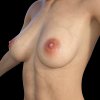- Jul 4, 2017
- 3,441
- 6,624
- 707
I would also like to get advice about this topic. Your questions about focus and fisheye show that you are already on the path of understanding.Where can I learn about POV artwork?
I'm getting a new computer that should be able to render better than anything I've tried in the past, and I was interested in trying my hand at some ero-artwork. I was thinking about artwork in the style of WVM, Being a Dik, My Sweet Neighbors, where most images portray the female characters relating to the fourth wall as if it were a person. I really love this effect, and I want to do some of it myself.
Are there tutorials that would show how to portray a scene from the protagonist's pooint of view? I'm thinking about things like fisheye and planes of focus, to make the images really look like what you're seeing is in front of you.
However this is what I have gleaned so far:
1. The field of view of a human eye is complex: sharp focus in the centre, very poor focus everywhere else. But your brain assembles the image in front of you so it all feels sharp. The realtive area you can see in sharp focus changes dramatically as the object is closer or further from the eye.
2. There are certain conventions used in photography, art and movies - to move too far away from these conventions is risking misunderstanding by the viewer. 35mm camera view is a good example of a common and widely recognised "window to the world".
3. "Wide screen" 16:9 or even crazier cinema views like 2.1:1 are good for movie theatre construction costs (don't need a crazy high roof compared to the number of seats in the room) but are not necessarily the best for mimicking a human's P.O.V., But that is the world of hardware (computer screens) in which we live. And now of course mobile devices are breaking the traditions again (cue the screams of hatred at vertical phone videos)
4. Trying to do realistic sharp focus with a lens (including a simultated render lens) is troublesome - you end up losing something in either the apparent field of view, or the sharpness of focus plane, etc. There are many established techniques in cinematography to play with this relationship (which have now become almost like tropes) so that might be a good place to start.
If you think about the common Visual novels, they generally go either of two ways:
* Japanese style traditional VN/Eroge: Background image, possibly out of focus + sharp character Tachie in the foreground
* Full view custom image for every scene
First type is more common for hand drawn art, as the cost of drawing out every minor dialogue scene would be huge. So the effort is restricted to a small number of BG images, 2-8 character images (or perhaps less but with different face expressions) and perhaps overlay clothes. Then the important ecchi scenes will get one or a few full screen images each. Total drawing budget might be 40-100 images.
Second type is more common with 3d render, as the cost can be much lower - once you have your scene and characters, you can make many images with different poses / camera positions at shorter time.




